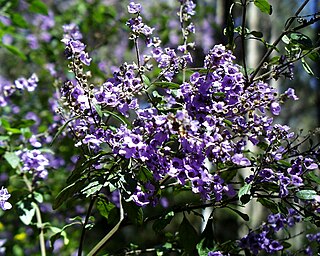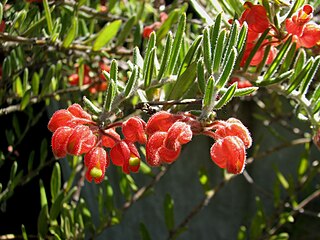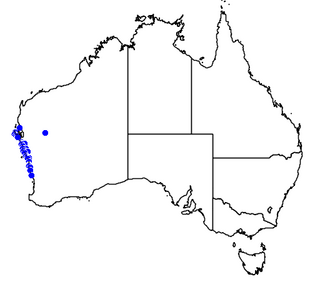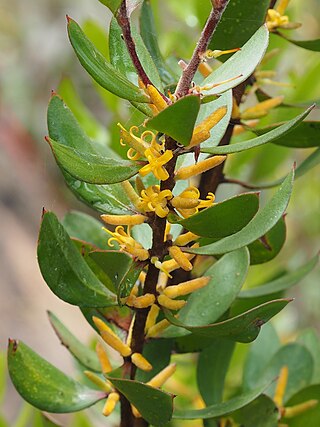
Prostanthera melissifolia, commonly known as balm mint bush, is a species of flowering plant in the family Lamiaceae and is endemic to south-eastern Australia. It is an erect shrub with hairy branches, egg-shaped leaves with fine teeth on the edges and mauve to purple or pink flowers on the ends of branchlets.

Grevillea oldei is a species of flowering plant in the family Proteaceae and is endemic to a small area of eastern New South Wales. It is a diffuse shrub with narrowly egg-shaped to more or less triangular leaves, and red flowers.

Seringia arborescens is a species of flowering plant in the family Malvaceae and is endemic to eastern Australia. It is an erect, spreading shrub or small tree with egg-shaped to lance-shaped leaves and cream-coloured or greenish-white flowers, usually in groups of 10 to 40.

Thomasia purpurea is a small, flowering shrub in the family Malvaceae that is endemic to the southwest of Western Australia. It has green oblong-shaped leaves and pinkish purple flowers.

Grevillea saccata, commonly known as pouched grevillea, is a species of flowering plant in the family Proteaceae and is endemic to the south-west of Western Australia. It is a low, spreading to diffuse, scrambling or trailing shrub with linear to oblong or egg-shaped leaves with the narrower end towards the base, and small clusters of red and orange flowers with a lime-green style.

Commersonia borealis is a species of flowering plant in the family Malvaceae and is endemic to the southwest of Western Australia. It is a low growing, spreading shrub with egg-shaped to oblong leaves, and white, yellow and cream-coloured flowers.

Persoonia oleoides is a species of flowering plant in the family Proteaceae and is endemic to north-eastern New South Wales. It is an erect to low-lying shrub with oblong to egg-shaped leaves and yellow flowers in groups of up to twenty-five on a rachis up to 130 mm (5.1 in) long.

Grevillea humilis is a species of flowering plant in the family Proteaceae and is endemic to eastern New South Wales. It is an erect to spreading shrub with narrowly elliptic to more or less linear leaves, and pink or white flowers.
Kunzea calida is a plant in the myrtle family, Myrtaceae and is endemic to Queensland, Australia. It is a spreading shrub which has linear to lance-shaped leaves but which are rolled, making them appear cylindrical. The flowers are pinkish-purple and arranged in groups near the ends of the branches in September. It is only known in remote and rugged areas of the Mount Stewart Ranges near Homestead.
Prostanthera athertoniana is a species of flowering plant in the family Lamiaceae and is endemic to a restricted area of Queensland. It is a small, densely-foliaged shrub with strongly aromatic, elliptical, oblong or egg-shaped leaves and hairy, purplish-mauve flowers arranged singly in upper leaf axils.
Hibbertia cistifolia is a species of flowering plant in the family Dilleniaceae and is endemic to northern Australia. It is a prostrate to low-lying sub-shrub with trailing, wiry stems, hairy foliage, oblong to elliptic leaves and yellow flowers arranged in leaf axils, with forty to fifty-eight stamens arranged around the two carpels.
Seringia exastia, also known as fringed fire-bush, is a species of flowering plant in the mallow family and is endemic to the Kimberley region of Western Australia.
Thomasia dielsii is a species of flowering plant in the family Malvaceae and is endemic to the south-west of Western Australia. It is a low, erect to spreading shrub with egg-shaped leaves with wavy edges, and purple, violet and blue flowers.
Thomasia × formosa is a species of flowering plant in the family Malvaceae and is endemic to a restricted area of the south-west of Western Australia. It is an erect, compact shrub with densely hairy branchlets, hairy, coarsely serrated, egg-shaped to elliptic or oblong leaves, and racemes of pink or purple flowers arranged in leaf axils.

Androcalva johnsonii is a species of flowering plant in the family Malvaceae and is endemic to central Queensland. It is a low, spreading shrub that has hairy young branches, narrowly egg-shaped or oblong leaves with rounded teeth, and small groups of white to pale pink flowers.
Androcalva perkinsiana, commonly known as headland commersonia, is a species of flowering plant in the family Malvaceae and is endemic to a restricted part of central eastern Queensland. It is a small, erect shrub with hairy young branchlets, oblong or lance-shaped leaves with 5 to 11 pairs of small serrations on the edges, and groups of 3 to 4 pale purple flowers.
Guichenotia anota is a flowering plant in the family Malvaceae and is endemic to a restricted part of the southwest of Western Australia. It is a low, erect, compact shrub with hairy new growth, oblong to narrowly egg-shaped leaves, and pinkish-purple flowers.
Seringia adenogyna, commonly known as skinny-leaved fire-bush, is a species of flowering plant in the family Malvaceae and is endemic to the south-west of Western Australia. It is an erect shrub with hairy new growth, linear to narrowly oblong leaves and purple flowers usually in groups of 2 to 4.
Seringia adenolasia is a species of flowering plant in the family Malvaceae and is endemic to northern Australia. It is a sticky, aromatic densely hairy shrub with egg-shaped to lance-shaped leaves sometimes with toothed edges, and creamy-pink or purple flowers, usually in groups of up to 5.

Seringia cacaobrunnea, commonly known as chocolate fire-bush, is a species of flowering plant in the family Malvaceae and is endemic to the south-west of Western Australia. It is a bushy shrub with hairy new growth, oblong to elliptic leaves and purple flowers in groups of 3 to 11.










